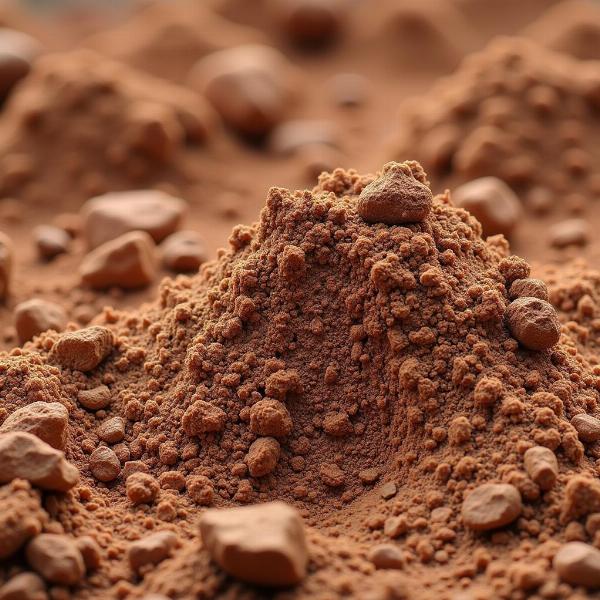Clay soil, a common soil type found across India, plays a crucial role in agriculture and construction. Understanding its properties and characteristics is essential for successful cultivation and building practices. But what exactly does “clay soil” mean in Hindi? This article will delve into the meaning, properties, advantages, disadvantages, and various uses of clay soil, providing a comprehensive understanding of this vital natural resource.
Understanding Clay Soil: Meaning and Composition
Clay soil, known as चिकनी मिट्टी (chikni mitti) in Hindi, is a type of soil that is composed of very fine mineral particles. These particles are smaller than 0.002 millimeters in diameter, making them significantly smaller than sand or silt particles. This fine texture gives clay soil its unique properties, including its high water retention capacity and its ability to form a sticky, malleable mass when wet. This stickiness is a key identifying feature of clay soil.
 Close-up view of clay soil texture
Close-up view of clay soil texture
Advantages of Clay Soil
Clay soil offers several advantages, particularly in agriculture:
- High Water Retention: The tiny particles in clay soil create small pores that trap water effectively. This high water retention capacity is beneficial in areas with limited rainfall, providing a consistent moisture source for plants.
- Nutrient-Rich: Clay soils are often rich in nutrients essential for plant growth, such as potassium, calcium, and magnesium. These nutrients are held tightly by the clay particles, preventing them from being easily leached away by water.
- Ideal for Certain Crops: Certain crops, like rice and sugarcane, thrive in clay soils due to their high water requirements and the soil’s ability to provide support.
Disadvantages of Clay Soil
Despite its benefits, clay soil also presents some challenges:
- Poor Drainage: While water retention is an advantage, excessive water can lead to waterlogging and root rot in plants. The small pores restrict water movement, making drainage a significant concern in clay soils.
- Difficult to Work With: Clay soil can be difficult to till and cultivate, especially when wet. Its sticky nature makes it challenging to plow and can damage gardening tools.
- Slow Warming: Clay soil takes longer to warm up in spring compared to sandy soils, which can delay planting and affect crop growth.
Various Uses of Clay Soil
Beyond agriculture, clay soil has several other applications:
- Pottery and Ceramics: Clay’s malleability makes it ideal for creating pottery, bricks, and other ceramic items. It can be shaped and molded easily, and when fired at high temperatures, it hardens into a durable material.
- Construction: Clay is used in construction as a building material, particularly in the production of bricks and tiles. Its strength and durability make it a suitable choice for various structural applications.
- Medicinal Uses: In some traditional medicine practices, clay is used for its absorbent properties. It can be applied topically to draw out impurities or ingested to alleviate digestive issues.
What Does Clay Soil Feel Like?
Clay soil has a distinct feel. When dry, it feels hard and compact, almost like concrete. When wet, it becomes sticky and pliable, easily molded into different shapes. This characteristic stickiness is a crucial indicator of clay soil.
Clay Soil Management Techniques
Several techniques can improve the drainage and workability of clay soil:
- Adding Organic Matter: Incorporating organic matter, like compost or manure, improves soil structure and drainage.
- Raised Beds: Creating raised beds improves drainage and allows for earlier planting in spring.
- Aerating: Aerating the soil helps to break up compacted clay and improve water infiltration.
Conclusion
Clay soil, or चिकनी मिट्टी (chikni mitti), is a valuable resource with both advantages and disadvantages. Understanding its properties is essential for effective management in agriculture and other applications. By implementing appropriate techniques, the challenges associated with clay soil can be overcome, maximizing its potential benefits.
FAQ
- What is the meaning of clay soil? Clay soil is a type of soil made up of very fine mineral particles, giving it a sticky texture when wet.
- Is clay soil good for farming? Clay soil can be good for farming certain crops, but it requires careful management due to its drainage and workability issues.
- How can I improve clay soil drainage? Adding organic matter and aerating the soil can improve drainage in clay soils.
- What is the Hindi word for clay soil? The Hindi word for clay soil is चिकनी मिट्टी (chikni mitti).
- What are the uses of clay soil besides farming? Clay soil is used in pottery, construction, and even some traditional medicine practices.
- How can I tell if my soil is clay? Wet a handful of soil. If it feels sticky and can be easily molded, it likely contains a high percentage of clay.
- What crops grow well in clay soil? Rice, sugarcane, and certain types of vegetables can thrive in clay soils.
Meaning-Hindi.in offers professional translation services specializing in various fields, including technical, legal, business, and educational document translation. Whether you need accurate translations of technical manuals, legal contracts, or educational materials, our expert linguists ensure precise and culturally sensitive translations. We also provide website localization and fast turnaround translation services. Contact us today for all your translation needs! Email: [email protected], Phone: +91 11-4502-7584. Meaning-Hindi.in is your trusted partner for high-quality Hindi translation services.